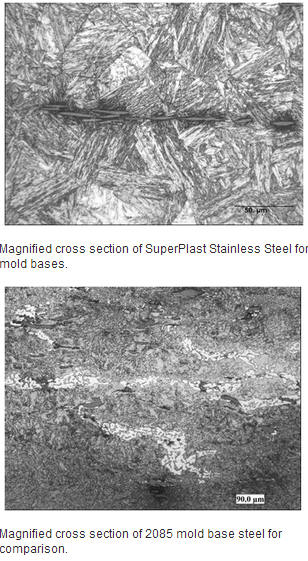Article
New stainless mold base steel offers high machinability and improved thermal conductivity

By Clare Goldsberry
Published: June 5th, 2014
Reprinted with permission from UBM Canon.
Industeel ArcelorMittal has developed an original patented free-machining martensitic stainless steel called SuperPlast Stainless (SPS), that has seen good success in the marketplace among mold base manufacturers. Mold bases manufactured with SPS offer high machinability to provide both high productivity and longer tool life, thus reducing costs. SuperPlast also provides high, consistent mechanical strength and hardness, optimum thermal properties to facilitate the removal of heat energy through cooling, and corrosion resistance to ensure mold durability and reduce maintenance costs.
Robert Esling, North American sales & marketing manager for Industeel ArcelorMittal in Troy, MI, said that the SuperPlast was developed in response to customer demand. “We needed this type of steel in our product line to give us a broader range of offerings,” Esling told PlasticsToday. “At the last NPE (2012), I began canvassing people in the mold industry, and met Paul Britton from International Mold Steel. It was the beginning of a great partnership for us. They began representing us for the SPS product in about March of last year.”
International Mold Steel’s Britton, national sales manager, said that “it was perfect timing” for the SuperPlast product to be introduced. “I’ve had customers asking us for stainless but we just couldn’t find the right one,” he added. “The main driver for us was our customers. We didn’t just want a run of the mill stainless – we wanted one with superior properties – we wanted something special and believed the SuperPlast filled that bill.”
“We thought it was a good opportunity to bring in a competitive material and Paul had customers beating on him for a good quality stainless product for mold bases,” Esling stated.
SuperPlast Stainless is delivered in a pre-hardened and tempered condition (ready-to-use), in the hardness range of 30/34 Rockwell HRC (tensile strength: 950-1050 MPa). To ensure consistent machining performance, it is critical to achieve uniform hardness throughout the whole plate.
SuperPlast Stainless has been engineered with low carbon content, combined with 12% chromium and the addition of alloying elements to achieve high mechanical strength and good corrosion resistance. An addition of sulfur combined with a specific treatment for sulfides aims to improve the machinability of the new steel.
As machinability is a key end user value for mold base steels, it is necessary to evaluate the performance of the newly developed grade against the standard grade(s) AISI 420 FM (2085). As milling performance is closely linked to cutting conditions (cutting tools and parameters used) besides the work piece material, milling test results are valid under the following testing conditions:
- High feed milling cutter AJX502 Mistubishi
- Coated insert JDMW 120420 ZDSR-FT-FH7020
Additionally, when machining the new steel grade the tool life was 59% to 72% longer than the one obtained when milling the standard steel, depending on the wear criterion considered.
An injection mold is designed to contain the polymer melt within the mold, efficiently transfer the thermal energy from the hot polymer to the cooler mold steel to provide uniform plastic parts, and eject parts that conform to specification and with optimum cycle time. Good thermal conductivity enables the molder to save costs and increase productivity thanks to faster cycle times and better part quality. The higher the thermal conductivity, the faster the heat will be removed from the plastic and from the mold, Esling and Britton explained.
Esling said that the market potential for using stainless steel for mold bases is approximately 30%-35%. “Most of the mold bases are 1020 (A36) or P20 or 4140,” he said. “Demand for the stainless steel mold base is the price drivers you are dealing with. For small, low production molds you’ll probably go the cheaper route. The stainless steel is more for high-volume, high productivity molds.”
SuperPlast Stainless has been quite well received in the market. Many of the mold base suppliers and even the mold manufacturers who make their own bases are happy to see an additional supplier. “One supplier had 75-80% of the market and we saw an opportunity to take some of that market,” said Esling. “It’s been well received just on that basis alone. They wanted another material so as not to be single sourced.”
